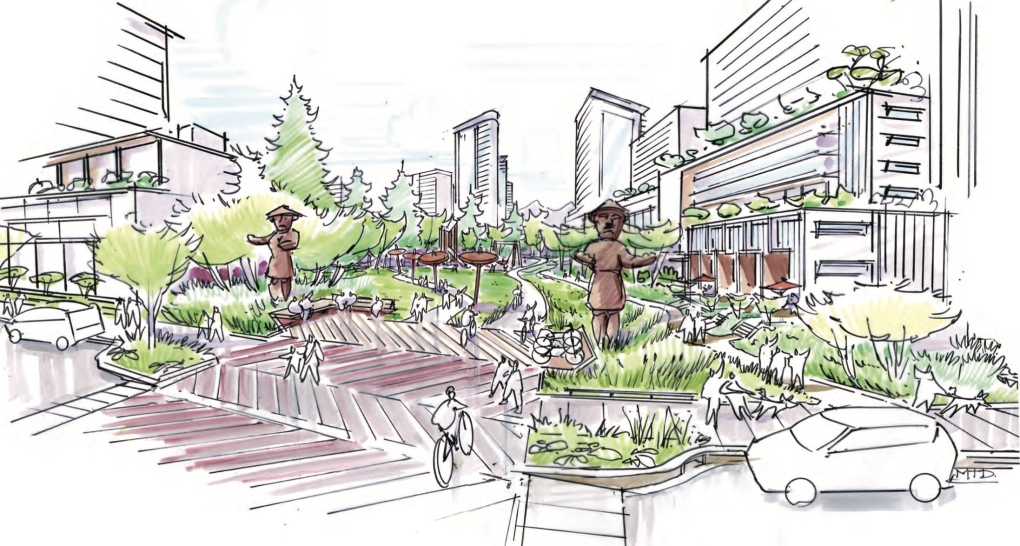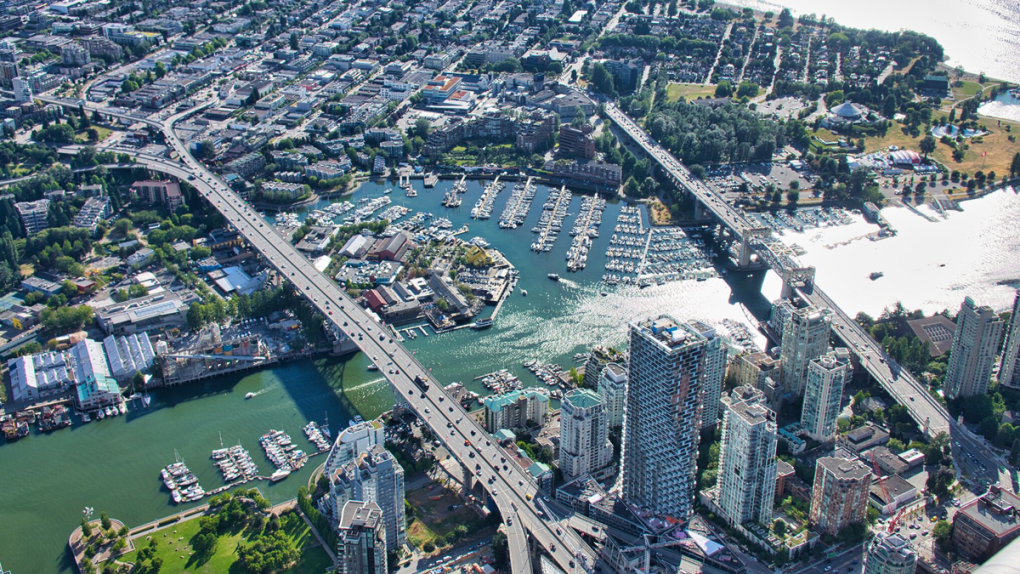'You of all people should understand,' Vancouver councillor tells Indigenous leader of removing Mountie's urn for construction
A meeting about a Vancouver redevelopment plan and the fate of a heritage building got a bit heated when a city councillor asked whether those behind the Indigenous-led project knew the remains of an RCMP officer were buried at the site.
The meeting was not about the remains. Its purpose was for council and the public to discuss with the project leaders what the major redevelopment, which includes hundreds of new housing units, will look like, and to determine whether the land should be rezoned.
But part of that plan includes what to do with an old building on the lot. City staffers had been asked at a previous meeting to look into whether it could, and should, be relocated.
It would cost nearly $50 million to move and upgrade the more-than-a-century-old building, city staff estimated while recommending that it instead be torn down.
According to a report presented at a public meeting last week by Kirsten Robinson, a senior planner with the city, the estimated cost of saving the Fairmont building, which is currently on the Heather Lands, would be "upwards of $47 million."
The building is listed in the city's heritage register in the "A" evaluation category, meaning the exterior is fully protected from inappropriate alteration. In some cases, buildings in this schedule are also protected from select interior and landscape alterations.
PHYSICAL REMINDER OF 'ATROCITIES'
The building exists on land that will be home to the city's largest-ever Indigenous-led redevelopment project, and its history includes being home to the RCMP as both the Fairmont Barracks and the Fairmont Training Academy.
It was built as the Langara School for Boys just before the First World War, City Coun. Colleen Hardwick said, then became a military hospital before it was an RCMP station.
She asked whether instead it should be repurposed, listing examples of other controversial buildings that remain standing with reconciliation in mind.
She said this after city staff described it as a physical symbol of the RCMP's role in enforcement of the Indian Act and other discriminatory laws against Indigenous peoples, and as a symbol of colonialism.
Adrienne Charlie of the Sḵwx̱wú7mesh (Squamish Nation) said it was part of a discussion as recently as the morning before the meeting. The meeting was just days after a gathering near the Kamloops Indian Residential School – one of these buildings – where the anniversary of the discovery of what are believed to be the remains of children was marked in a day-long ceremony.
"One of the hardest things that this country was built on was the overtaking of our land, and I think the biggest part is us taking back our land, and taking ownership of who we are as people," Charlie said.
"The atrocities that the RCMP have done to our people (were) so hard. Many of our family (members) never came home. Many of our children … The RCMP was built to help the country impede within our people, and I'm not saying that the churches weren't a part of it, and these schools weren't there. Our people are utilizing these buildings."
She said those behind the project have talked about moving it, and that they're willing to go along with that, "but I think the replacement of the cultural centre is what is important to us."
 A concept sketch from a proposal for the Heather Lands is shown.
A concept sketch from a proposal for the Heather Lands is shown.
'SO, PUT IT IN THE LANDFILL. THAT'S VERY GREEN.'
Still, the city directed its staffers to look into whether it was feasible to move it from the site, given that it is a historical building.
It is physically possible to relocate the building, staff said last week, but they were unable to find a suitable location within 1.5 kilometres of its current location. The search included nearby land slotted for redevelopment, public parks as well as single-family lots in the area.
And the cost would be tens of millions of dollars.
 The Heather Lands site is shown on a map included in a City of Vancouver presentation.
The Heather Lands site is shown on a map included in a City of Vancouver presentation.
Initially the project was estimated to require a budget of around $6 million just to move it, a staff member told council. That estimate was from 2017. The upgrades would cost another $41 million.
But given they'd have to move it further away than the 1.5-kilometre radius, the bill would likely be even higher, Robinson said.
And while the building is in the city's heritage register, it is not actually protected because the policy statement set by the previous council for the property supersedes the 2020 heritage policy, staff told council. Nor is that necessarily in the city's best interest "in the spirit of reconciliation."
Asked whether they'd considered the environmental impact of tearing the building down, staff said a full analysis was conducted and that the recommendation from the director of planning was to demolish it.
Instead, staff recommended the council approve removal of the building, to which Hardwick responded sarcastically, "So, put it in landfill. That's very green."
'EVIDENCE OF A BURIAL'
Hardwick said there was a "piece of correspondence" suggesting there was "evidence of a burial" on the site of at least one RCMP officer.
Robinson said veterans of the RCMP said there is believed to be an urn under the flagpole, but that those working on the site will remove the remains.
The question did not go over well with some in attendance.
Squamish Nation Coun. Syexwáliya Ann Whonnock said multiple members of her family were buried at the footing of the Burrard Street Bridge.
"No consideration was given for feelings and our families, and we were forced to dig them up and move them up to where our family lived, 25 miles up the Squamish River. Then the land was expropriated, given as a tree farm licence, and a logging road had to be constructed, and they were asked again to move the remains," she said.
 The Burrard Bridge and Granville Street Bridge are seen from the air in June 2019. (Pete Cline / CTV News Vancouver)
The Burrard Bridge and Granville Street Bridge are seen from the air in June 2019. (Pete Cline / CTV News Vancouver)
Whonnock said other families too have similar stories, so context is important.
"I just had to share that because you hit my heart when you said that," she said, telling the councillor no one thought about her deceased family members when their remains were dug up to help the city.
Hardwick said, "You of all people then would appreciate the sensitivity that the families would feel."
REMOVAL OR DEMOLITION?
By the end of the meeting, council approved the redevelopment plan that includes the removal of the Fairmont building, which will be replaced in a later phase of the project with an Indigenous cultural centre, but it's still unclear what will happen when it's removed.
A city spokesperson told CTV News that it's possible, though "unlikely given significant challenges" that an alternative site could be found before construction crews need it to be demolished.
Charlie said if someone was willing to pay to move it, the three First Nations would be willing to support the moving of the building.
CTVNews.ca Top Stories

Bodies found by U.S. authorities searching for missing B.C. kayakers
United States authorities who have been searching for a pair of missing kayakers from British Columbia since the weekend have recovered two bodies in the nearby San Juan Islands of Washington state.
Amid concerns over 'collateral damage' Trudeau, Freeland defend capital gains tax change
Facing pushback from physicians and businesspeople over the coming increase to the capital gains inclusion rate, Prime Minister Justin Trudeau and his deputy Chrystia Freeland are standing by their plan to target Canada's highest earners.
'It's discriminatory': Individuals refused entry to Ontario legislature for wearing keffiyeh
Individuals being barred from entering Ontario’s legislature while wearing a keffiyeh say the garment is part of their cultural identity— and the only ones making it political are the politicians banning it.
Tom Mulcair: Park littered with trash after 'pilot project' is perfect symbol of Trudeau governance
Former NDP leader Tom Mulcair says that what's happening now in a trash-littered federal park in Quebec is a perfect metaphor for how the Trudeau government runs things.
Saskatchewan households will continue to receive carbon tax rebate: Trudeau
Households in Saskatchewan will continue to receive Canada Carbon Rebate payments, despite the province refusing to remit the federal carbon price on natural gas, Prime Minister Justin Trudeau said Tuesday.
'It's just so hard to let it go': Umar Zameer still haunted by death of Toronto police officer
“It's just so hard to let it go. I mean, everyone is telling me, ‘you have to move on,’ but I know someone is not here [anymore]. So I don't know how I will move on." That’s what Umar Zameer, the man recently acquitted in the death of a Toronto police officer, told CTV News Toronto in a sit-down interview on Tuesday.
Senate expenses climbed to $7.2 million in 2023, up nearly 30%
Senators in Canada claimed $7.2 million in expenses in 2023, a nearly 30 per cent increase over the previous year.
Canucks goalie Thatcher Demko won't play in Game 2
The Vancouver Canucks will be without all-star goalie Thatcher Demko when they face the Nashville Predators in Game 2 of their first-round playoff series.
Pedestrian, baby injured after stroller struck and dragged by vehicle in Squamish, B.C.
Police say a baby and a pedestrian suffered non-life-threatening injuries after a vehicle struck a baby stroller and dragged it for two blocks before stopping in Squamish, B.C.































